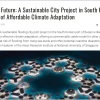Summary
This paper was commissioned to further go into depth of mainstreaming water adaptation at urban, and national level.
This paper is a desk study that identifies and documents the successful mainstreaming of water climate adaptation in four countries and related cities, and based on these case studies assess the applicability of key international frameworks, guidelines, and tools available for mainstreaming water climate adaptation. It is complemented by another report which was commissioned at the same time, and looks at the transboundary level.
The papers will be a resource for further strategic work within the Water Program at GCA and its working areas including: the Water Adaptation Community, the City Adaptation Accelerator (CCA), and Climate Resilient Water Services that are part of the African Adaptation Accelerator Program (AAAP).
Mainstreaming Water Adaptation Journey – a roadmap for mainstreaming water adaptation at national, urban and basin levels have been developed as an organizing principle for the Water Adaptation Community. On the WAC this roadmap is referred to as the Adaptation Journey, and WAC content can be tagged to populate knowledge which relates to the roadmap. For example, the CAA risk assessments are provided as case studies and is providing practical content on the mainstreaming step “Assessing Risk” with its own dedicated space. A part of the WAC video describes this roadmap and includes interviews with experts in the field.
Some key insights from the report
- Climate policies are essential to mitigate climate change and to develop successful adaptation processes. Many of these climate policies are already translated into National Determined Contributions (NDC’s) and National Adaptation Plans/ Strategies (NAP’s/NASs.) as presented in chapter 3. However, this can be improved, for example through developing clear synergies between adaptation and mitigations opportunities through water that are practically non-existent in the NDCs.
- It is important to recognize that, many of the looked after climate policies and related NAPs tend to reflect a more global agenda and perspective (read: a very generalized view at the level of recognition of theme-importance) and do pay less attention (if any) to national/regional vulnerability and contexts, let alone the site specific requirements at the local level (where adaptation will have to be achieved to be effective).
- The case studies described in this study show that mainstreaming water climate adaptation (MWCA) in policies indicate that national governments and municipalities have good awareness of the needs for MWCA (some more than others), reflect the issues in policy frames and international contributions and are definitive supportive for the implementation of adaptation measures. But it is in the translation to local level interventions and their implementation where actions (and results) are often insufficient (except for the Netherlands and Dordrecht).
- Additionally, a predominant interest (or attention) is being paid to the risk and effects of floods, and much less to the impacts and more gradual effects of the increasing occurrence and length of droughts and/or negative effects of bad water quality. In the analyzed case studies, drought is
mentioned in the documents, but implementation of adaptation action is mainly focusing on floods. Even in The Netherlands the issue of drought was really experienced in 2020 and was a wake-up call. - There is a strong need to further integrate efforts to achieve the individual SDGs. Many international organizations including the UN office for Disaster Risk Reduction (UNDRR) and The Organization for Economic Cooperation and Development (OECD), promote the integration of climate change adaptation principles, formally delineated in the Paris agreement and the Disaster Risk Reduction Principles outlined by the Sendai framework for DRR.
- As described in chapter 3, a broad spectrum of scientific papers, tools, guidelines, and principles on and for “Mainstreaming climate change adaptation into development planning” is presently available. The UNDP-UNEP 41 guide for practitioners is a good starting point for mainstreaming water climate adaptation, proposing to better focus attention on the water dimension.
- Although these OECD principles proved to be useful and relevant in many countries,
they do not yet account for two fundamental aspects of adaptive water – climate management,
namely: 1) designing and managing of a process of adaptive planning with a long-term perspective. 2) Risk-based approach to adequately manage extreme events, such as floods and droughts. Adding these water-climate adaptation aspects to the exiting OECD guidelines on water governance may strongly increase their immediate relevance in stimulating adaptation mainstreaming. - Regulatory and institutional frameworks are of course the basis for adaptation potential, but local government especially “requires strong and clear support from state government in order to progress adaptation”. The lack of interaction or translation from national level to the local (city) level is a reoccurring observation in this study.
- More on barriers to adaptation and lock -ins
- What the drivers are for change (sense of urgency, leadership, coalition of the willing and doing, communication, etc.)
- Recommendations
READ THE REPORT for a full summary












Trending Discussions
From around the site...
“Absolutely interested! I'll connect via email to discuss reviewing and enhancing the Economic Analysis of Climate...”
Adaptation-related events at COP28 (all available to follow/stream online)
“Please check out these adaptation-related events taking place at COP28 - all available online (some in person too if...”
Shining a light for biodiversity – four perspectives to the life that sustains us. Four hybrid sessions.
“30 November to 19 December 2023 - Four Sessions Introduction The SDC Cluster Green is happy to invite you to the...”